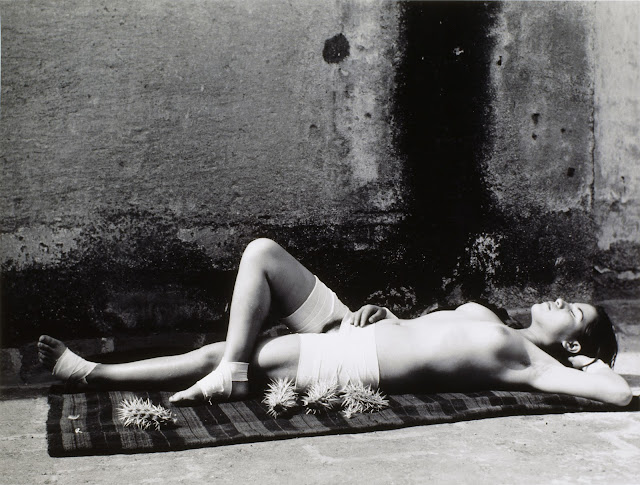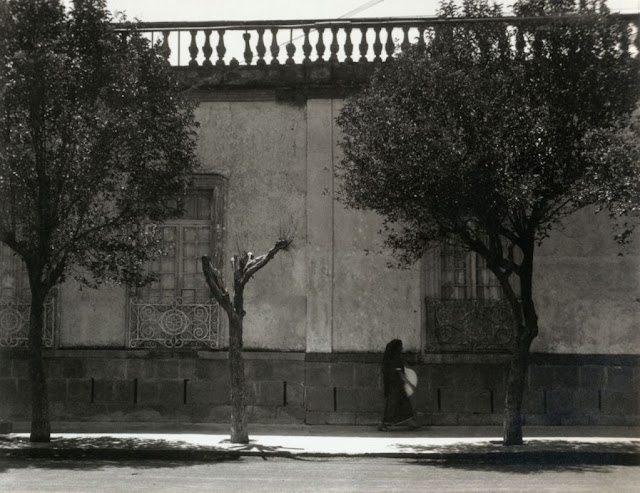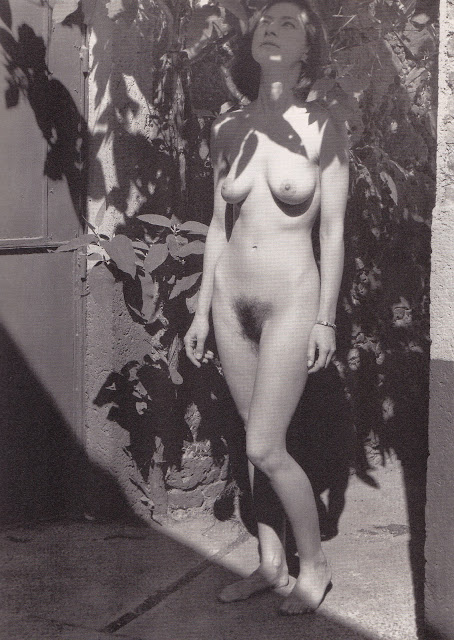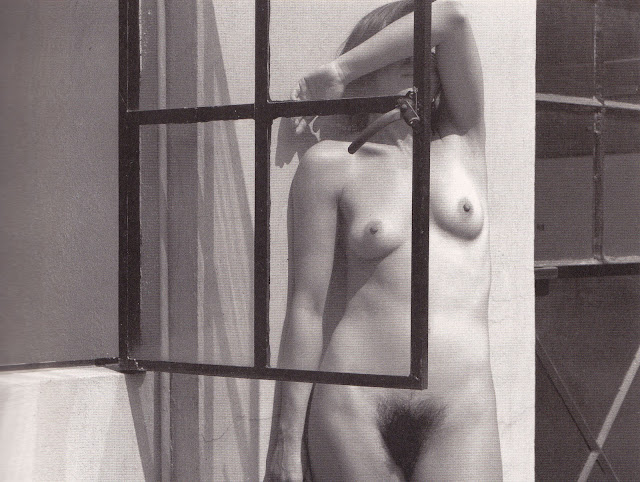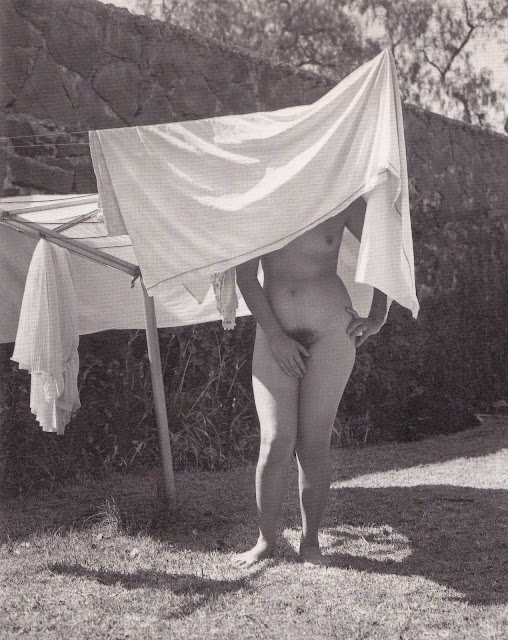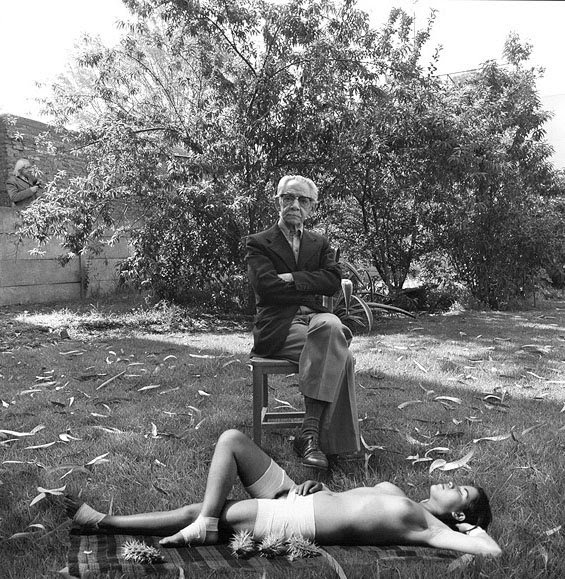Álvarez Bravo was born in Mexico City in 1902. He came from a family of artists, and met several other prominent artists who encouraged his work when he was young, including Tina Modotti and Diego Rivera.
He studied painting and music at the Academia Nacional de Bellas Artes in 1918, but did not begin experimenting with photography until the mid 1920's. Though he was never formally a member of the surrealist movement, his work displays many characteristics of surrealism, and he was exposed to many of its founders. His work often suggests dreams or fantasies, and he frequently photographed inanimate objects in ways that gave them humanistic qualities.
From 1929 through the mid-1930s Alvarez Bravo's photographs are indeed dominated by pictures he made in the urban streets - shop windows jammed with goods, advertising billboards slipped into the architecture, and vignettes from life's ongoing mini-dramas as they played themselves out. While Henri Cartier-Bresson and the other French photographers of the "social fantastic" used the Leica 35mm camera, Alvarez Bravo used a Graflex camera, which has a larger negative and requires more time between exposures. Asked if he had used a Leica soon after its invention, Alvarez Bravo reported that Rodolfo Mantel, the photographic supply salesman who suggested him for Primer salon Mexicano de fótografia in 1928, received the first Leica in Mexico: "One day, while he was trying it out, he took a photo of me and I took one of him. He developed the negative, and it was very grainy.... I didn't buy this Leica .... Photographers thought that Leicas were toy cameras."
The larger negative of the Graflex provided more detail in the finished print, and was particularly suited to Alvarez Bravo, whose pictures appear to derive from a thoughtful, more deliberate, intellectual manner of picture-making, rather than a reliance on his immediate instincts, as was true in the work of Cartier-Bresson, for example. [via Wiki and MoMA]

Optical Parable is one of Alvarez Bravo's most famous pictures. In it, the negative has been reversed in the printing, so that our eyes are momentarily tested - part of the experience of a visit to the optician. Alvarez Bravo has commented that he was interested in our experience of a shop and its window as one approaches it from the outside, and then, upon entering and looking back out, how we experience everything in reverse: the window and the signs. The picture is a metaphor for all of life's experiences - the idea of reversal, the idea of opposites, the idea of inside and out - and it provides us with the opportunity to experience the idea of reversed experience, as a work of art. There is also something uncanny in our experience of the photograph through the trick Alvarez Bravo has momentarily played on us - it turns out that the world is not what we think it is. [via MoMA]
The Daydream of 1931 is a simple, direct picture of a young girl standing on a balcony caught in a wistful moment by the photographer. Alvarez Bravo glanced up to see the girl as he sat reading Dostoevski in the tenement where he lived, jumped up to retrieve his Graflex, and returned to find her in the same pose. Despite its simplicity, the picture is a rhapsody of longing, lament, or revery. The construction of the picture puts the young woman at some distance from us, behind the barrier of the fence whose angles are repeated in the angle formed by the position of her arms. The light on her right side, and especially on her shoulder, seems to emanate from above, singling her out. Her insulated experience is not betrayed by the photographer, or by us, in the slightest. In its quietude and its sense of the solitary, the picture exists in a kind of vacuum, while it simultaneously conveys its message across time and place. [via MoMA]









The larger negative of the Graflex provided more detail in the finished print, and was particularly suited to Alvarez Bravo, whose pictures appear to derive from a thoughtful, more deliberate, intellectual manner of picture-making, rather than a reliance on his immediate instincts, as was true in the work of Cartier-Bresson, for example. [via Wiki and MoMA]

Optical Parable is one of Alvarez Bravo's most famous pictures. In it, the negative has been reversed in the printing, so that our eyes are momentarily tested - part of the experience of a visit to the optician. Alvarez Bravo has commented that he was interested in our experience of a shop and its window as one approaches it from the outside, and then, upon entering and looking back out, how we experience everything in reverse: the window and the signs. The picture is a metaphor for all of life's experiences - the idea of reversal, the idea of opposites, the idea of inside and out - and it provides us with the opportunity to experience the idea of reversed experience, as a work of art. There is also something uncanny in our experience of the photograph through the trick Alvarez Bravo has momentarily played on us - it turns out that the world is not what we think it is. [via MoMA]
The Daydream of 1931 is a simple, direct picture of a young girl standing on a balcony caught in a wistful moment by the photographer. Alvarez Bravo glanced up to see the girl as he sat reading Dostoevski in the tenement where he lived, jumped up to retrieve his Graflex, and returned to find her in the same pose. Despite its simplicity, the picture is a rhapsody of longing, lament, or revery. The construction of the picture puts the young woman at some distance from us, behind the barrier of the fence whose angles are repeated in the angle formed by the position of her arms. The light on her right side, and especially on her shoulder, seems to emanate from above, singling her out. Her insulated experience is not betrayed by the photographer, or by us, in the slightest. In its quietude and its sense of the solitary, the picture exists in a kind of vacuum, while it simultaneously conveys its message across time and place. [via MoMA]

Mexican Artist Frida Kahlo








Manuel Alvarez Bravo Self Portrait with Nude
You have read this article black and white /
Character Portrait /
documentary photographer /
manuel alvarez bravo /
mexican photographer /
Spanish photographer
with the title Photographer Profile ~ The Poetic Eye of Manuel Alvarez Bravo. You can bookmark this page URL http://nikiinwonderland.blogspot.com/2012/03/photographer-profile-poetic-eye-of.html. Thanks!

